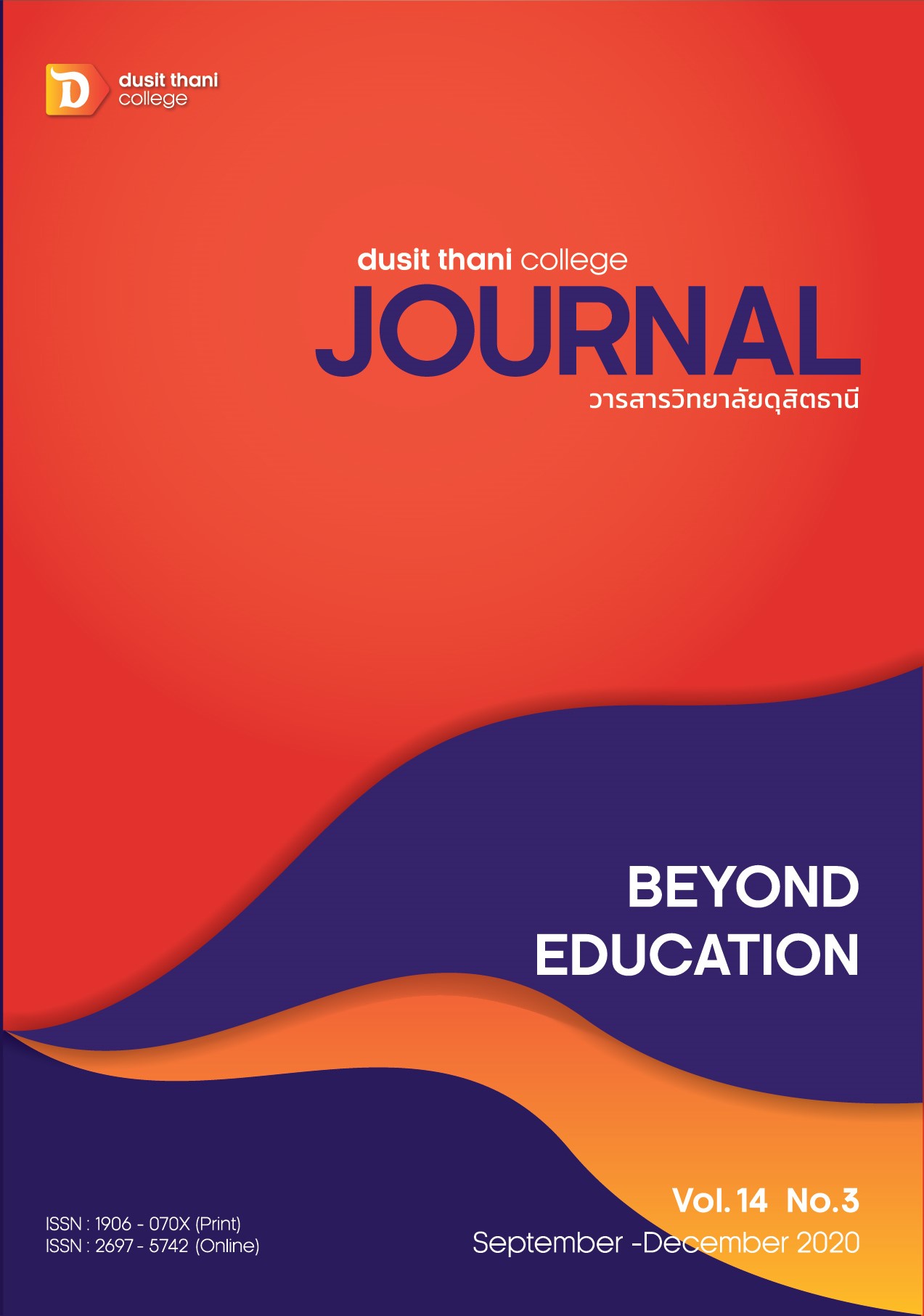Effects of Fat Replacement by Pectin from Dragon Fruit Peels on Physicochemical Properties of Salad Dressing
Main Article Content
Abstract
This research aimed to study the fat replacement with pectin from dragon fruit peels on physicochemical properties of salad dressing by studying the appropriate ratio of pectin as a fat replacer in salad dressing for 4 levels: 0% (control formula), 0.68%, 1.36% and 2.04%. Sensory characteristics, physicochemical properties such as color (L*, a* and b*), viscosity, rheological properties, pH, and peroxide values as well as nutritional values of salad dressing replaced with pectin from dragon fruit peels were evaluated. The results showed that pectin affects the consumer acceptance, physicochemical properties, and nutritional value of salad dressing. When increase the contents of pectin, b* value, viscosity and pH value decreased. Moreover, rheological properties and a* value increased (p <0.05). There was no change in peroxide value of salad dressing when replaced pectin at P 25 and P 50 level. The energy and fat composition of salad dressing was significantly decreased (p <0.05) as the ratios of pectin increased. Salad dressing with pectin replacement at 1.36% showed the highest acceptance. Therefore, the use of pectin for fat replacement in salad dressing products would be good for consumers. This study has shown the possibility of applying pectin as a fat replacer in salad dressings.
Article Details
Article Screening Policy
- All research and academic articles to be published must be considered and screened by three peer reviews in the relevant field / article.
- All articles, texts, illustrations and tables published in the journal are the personal opinions of the authors. Editors don't always have to agree. And no responsibility whatsoever is the sole responsibility of the author.
- The articles to be published must never be published. Where did you first publish? And not in the consideration of other journals If the audit found that there has been a duplicate publication It is the sole responsibility of the author.
- Any article that the reader sees as being plagiarized or impersonated without reference. Or mislead the work of the author Please let the journal editor know it will be your greatest blessing.
References
Dominiak, M., Søndergaard, K. M., Wichmann, J., Vidal-Melgosa, S., Willats, W. G. T.,
Meyer, A. S., & Mikkelsen, J. D. (2014). Application of enzymes for efficient extraction, modification, and development of functional properties of lime pectin.
Food Hydrocolloids, 40, 273-282.
Einhorn-Stoll, U. (2018). Pectin-water interactions in foods – From powder to gel.
Food Hydrocolloids, 78, 109-119.
Erçelebi, E. A., & Ibanoğlu, E. (2010). Effects of pectin and guar gum on creaming stability, microstructure and rheology of egg yolk plasma-stabilized emulsions.
European Food Research and Technology, 231(2), 297-302.
Gorji, S. G., Smyth, H. E., Sharma, M., & Fitzgerald, M. (2016). Lipid oxidation in mayonnaise and the role of natural antioxidants: a review. Trends in Food Science & Technology, 56, 88-102.
Hosseinvand, A., & Sohrabvandi, S. (2016). Physicochemical, textural and sensory evaluation of reduced-fat mustard sauce formulation prepared with Inulin, Pectin and β-glucan. Croatian journal of food science and technology, 8(2), 46-52.
Institution of Nutrition, M. U. (2018). Nutrients calculation software: INMUCAL- Nutrients V.4.0 (Version Database version NB.). Thailand.
Karas, R., Skvarča, M., & Žlender, B. (2002). Sensory quality of standard and light mayonnaise during storage. Food Technology and Biotechnology, 40(2), 119-127.
Kim, M. Y., Lim, S. H., & Lee, J. (2014). Intake of hot water-extracted apple protects against myocardial injury by inhibiting apoptosis in an ischemia/reperfusion rat model.
Nutr Res, 34(11), 951-960.
Li, J., Wang, Y., Jin, W., Zhou, B., & Li, B. (2014). Application of micronized konjac gel for fat analogue in mayonnaise. Food Hydrocolloids, 35, 375-382.
Ma, Z., & Boye, J. I. (2013). Advances in the design and production of reduced-fat and reduced-cholesterol salad dressing and mayonnaise: a review. Food and Bioprocess Technology, 6(3), 648-670.
Maneerat, N., Tangsuphoom, N., & Nitithamyong, A. (2017). Effect of extraction condition on properties of pectin from banana peels and its function as fat replacer in salad cream. Journal of Food Science and Technology, 54(2), 386-397.
Manomaiwajee, M. (2012). Oxidative stability of salad dressing containing blended cold-pressed edible oil enriched with crude from spanish plum leaf Elaeocarpus hygrophilus Kurz. (Master Degree). Chulalongkorn University, (In Thai)
Muhammad, K., Zahari, N. I. M., Gannasin, S. P., Adzahan, N. M., & Bakar, J. J. F. H. (2014).
High methoxyl pectin from dragon fruit (Hylocereus polyrhizus) peel. 42, 289-297.
Nazir, A., Asghar, A., & Aslam Maan, A. (2017). Food Gels: Gelling Process and New Applications. In Advances in Food Rheology and Its Applications (pp. 335-353).
Rogers, M. A. (2019). Encyclopedia of Food Chemistry: Fat replacers. In L. Melton,
F. Shahidi, & P. Varelis (Eds.), Encyclopedia of Food Chemistry (pp. 96-100).
Oxford: Academic Press.
Sangdad Publishing. (2006). Classic Salads. Bangkok: Sangdad Publishing. (In Thai)
Sun, C., Liu, R., Liang, B., Wu, T., Sui, W., & Zhang, M. (2018). Microparticulated whey protein-pectin complex: A texture-controllable gel for low-fat mayonnaise. Food Research International, 108, 151-160.
Tanasombun, P., & Pichaivongvongdee, S. (2017). Utilization of Broken Rice as a Fat Replacer in Low Calorie Tofu Salad Dressing. Journal of Food Health and Bioenvironmental Science, 10(3), 105-128.
Thai Industrial Standards Institute. (2004). Thai Industrial Standards Institute (TISI 672/2004) (In Thai)
Thibault, J.-F., & Ralet, M.-C. (2008). Pectins, their Origin, Structure and Functions. In B. V. Macleary & L. Prosky (Eds.).
Thomas, P. O. C., & Nora, M. O. B. (2016). Butter and Other Milk Fat Products: Fat Replacers. In Encyclopedia of Dairy Sciences (Vol. 2nd Edition, pp. 528–532). University College, Cork, Ireland.
Tongkham, N., Juntasalay, B., Lasunon, P., & Sengkhamparn, N. (2017). Dragon fruit peel pectin: Microwave-assisted extraction and fuzzy assessment. Agriculture and Natural Resources, 51(4), 262-267.
Wichienchot, S., Jatupornpipat, M., & Rastall, R. A. (2010). Oligosaccharides of pitaya (dragon fruit) flesh and their prebiotic properties. Food Chemistry, 120(3), 850-857.


